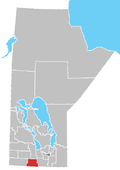Reserve lands
Swan Lake 7 | |
|---|---|
 Interactive map of Swan Lake 7 | |
| Coordinates: 49°23′09″N98°57′18″W / 49.3858131°N 98.9550057°W | |
| Area | |
| • Land | 27.72 km2 (10.70 sq mi) |
| Population (2016) [3] | |
• Total | 347 |
Swan Lake First Nation divided into 4 reserve lands: [1]
- Swan Lake 7 (IR 7) — surrounded by the Municipality of Lorne (Swan Lake); totalling 36.35 km2 (8,982 acres) in size, this is the First Nation's main reserve
- Forest Hills (IR 7a) — located by Carberry; totalling 26.36 km2 (6,514 acres) in size, it consists of residential and commercial developments
- Indian Gardens (IR 8) — located by Rathwell; totalling 2.6 km2 (640 acres) in size, most (75%) of this land is under agricultural lease
- Headingley (IR 8a) — located by the RM of Headingley; totalling 100,000 m2 (25 acres) in size, this location is planned to consist of mainly commercial developments
